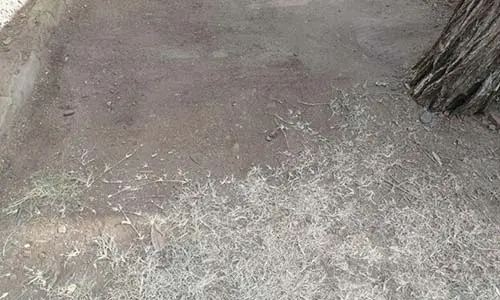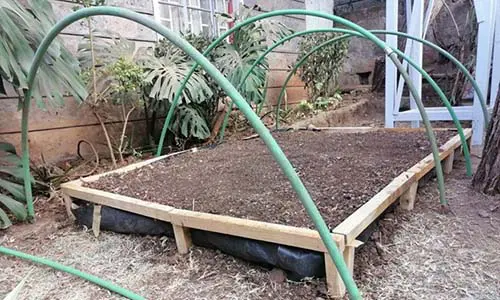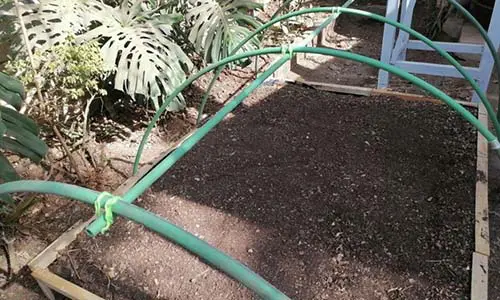As a homesteader, you need to be well-prepared for any crisis. For instance, you should know how to use survival off-grid tools, build a shelter, or grow enough food for your family.
Without electricity, water, or modern infrastructure, a simple greenhouse can be a good idea to grow your favorite plants. Remember that greenhouses are structures that allow you to control the environment that favors plant growth.
With a small greenhouse in your backyard, vegetables and fruits will grow in humid and warm conditions during winter.
I will demonstrate how to build a poor man’s greenhouse in this project. Also, I will include all the practical steps I used.
This project can take less than 30 minutes if you have all the necessary supplies within your home’s compound. However, it might be longer if you must gather supplies outside your compound.
Here are the steps I took.
Find Materials
For survival, the idea would be to use durable but economical materials. I used PVC pipes, a polythene cover, and a few lumber panels for the garden bed. All these materials were budget-friendly, with some available in my compound.
I decided to use polythene paper for the greenhouse cover because it is often the best material for different climates.
I used durable green PVC pipes because they flex easily without breaking the greenhouse hoop frame.
Choose An Ideal Area
Similar to a survival garden, the second step is choosing the ideal spot to build the greenhouse. You need an area that receives enough direct sunlight.
Never build the greenhouse under a tree or a roof because these obstructions prevent sunlight from hitting the greenhouse.
You should also confirm that the ground is level for the greenhouse to be firm.
Finally, check whether the drainage is adequate.

My greenhouse was next to a dried tree stump. So, that was also another reason I chose a raised garden bed. I knew that the tree had used up all the nutrients in the soil over the years it had been alive.
Prepare The Backyard
After you find the correct spot, prepare it well. I found an ideal area and cleared the ground by removing all stones, rocks, weeds, and wild grass.
Build The Garden Bed Perimeter
It is necessary to build a garden bed to provide a foundation for the soil.
I used a raised rectangular garden bed because, in this situation, it provides adequate drainage and gives the soil good aeration. I also learned that beds prevent pests and weeds from thriving – which is great.

Therefore, I used 7 feet by 5 feet garden bed to increase the volume of plant growth. However, you can adjust the measurements according to your preferences and the space you have.
Materials:
- Old lumbers
- Used nails
- Old wood screws
- Black vapor barrier
- Staples and pins

Fill The Garden Bed
I filled the garden bed with standard gardening soil, organic compost, and topsoil to provide enough properties that guarantee plant growth.

Afterward, I used a rake to level and clear the topsoil before I planted the seedlings. I left a 5-centimeter allowance from the tip of the bed to prevent the soil from overflowing whenever I watered the garden.
You can add organic additives like peat moss in the greenhouse to grow acid-loving plants like pepper or sweet potatoes.
Cutting Metal Rebars
You need eight pieces of (⅜ inches x 1 foot) rebars to support the PVC pipes. I used a 1-foot-long metal rebar because the soil in my bed was firm.

You can cut longer rebars that sink deep in the garden bed if your soil is loose. You can use more metal rebars if you want a bigger greenhouse.
Inserting The Rebars
Evenly mark where to put them along the length of the garden bed after all the support rebars are ready. However, these posts should be directly opposite each other for uniformity.

I hammered my metal posts 2 feet apart to support the greenhouse. But you should leave a few inches peeping above the ground.
Cutting And Positioning The PVC
After everything, you need to cut the PVC according to the length of your garden bed. In my case, I cut 7-foot-long PVC pipes.
Slide one end of the PVC pipe on one post, then bend and insert the other end on the opposite rebar post.

Continue until all the hoops are in place. If you like, add a horizontal running PVC pipe to increase support.
Before laying the polythene cover, I added a horizontal PVC pipe to support my greenhouse.

Always tie the horizontal PVC pipe underneath the hoops because it works better when tying up the polythene cover to the PVC pipe.
Drawing The Polythene Cover
Draw the polythene sheeting to cover the entire structure and secure it after all the hoops are secure.

I secured the sheeting with a few paving blocks to ensure the greenhouse had enough tension and did not lose moisture from any open spaces along the floor.

Fertilizing The Greenhouse
Always use organic vegetable waste as fertilizer to provide enough nutrients for plant growth in the greenhouse.

What You Need To Consider
If possible, build the greenhouse in an area that is not visible from the outside of your property, so it doesn’t attract looters in an SHTF situation.
A small indoor greenhouse would be ideal if you don’t have the space to build an outdoor greenhouse. Indoor greenhouses allow you to grow food even in bad weather.
Polythene covers are necessary to keep the greenhouse warm in winter. On the contrary, row plant covers are critical for keeping critters, birds, rodents, and other persistent pests away from your outdoor nursery.
Remember to include beneficial herbs that might be used as medicine for your family in a survival situation.
This article first appeared here.
You may also like:
Similar to Morphine: The Best Natural Painkiller that Grows in Your Backyard (Video)
How To Repurpose Old Items Into New Projects For Your Backyard















I would